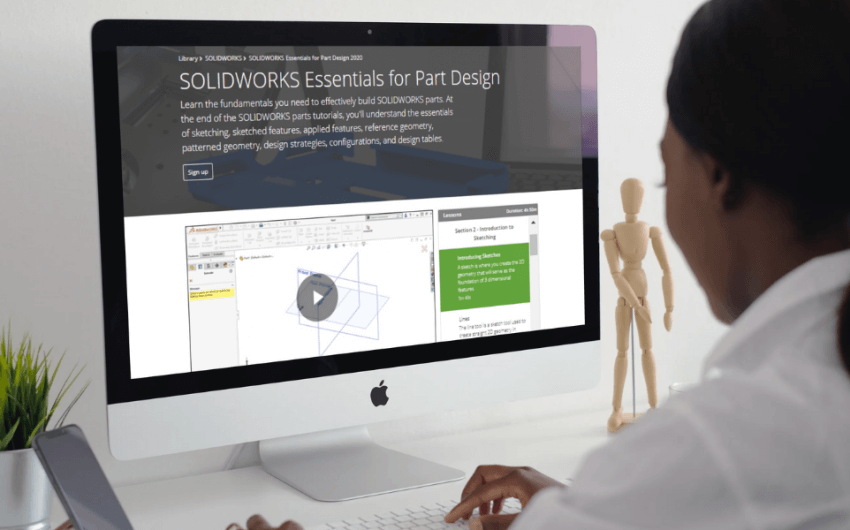At SolidProfessor, I regularly get to speak with our members, many of whom are managers responsible for providing learning resources to their teams. As a team manager myself, I enjoy asking others about the motivations, goals, and expectations they have when first launching learning initiatives. In time, I also get to learn about the results they achieve and the challenges they face along the way. Over the years, these conversations have yielded many valuable insights about continuous learning I’d like to share with you.

Provide a plan, not just a resource
One of the most common questions I’m asked is, “How do I get my team to engage?” This question is often posed by well-meaning managers who have made a new learning resource available to their team. After an initial spike in engagement, many notice their team beginning to use the resource less and less often until usage dwindles to nearly zero.
When we dig deeper, we generally find that there wasn’t a well-defined training plan or goals in place to guide the team. A learning initiative, like any other project, works best when expectations are clearly defined. In speaking with some of our most successful teams, there are a few simple planning and goal setting insights that can help your team:
Insights from successful teams
Identify areas for improvement.
You’ve likely already identified some areas that are in need of improvement if you’ve decided to look for a training resource. Writing these down, discussing them with your team, and getting everyone to buy in to improving these areas can help your team see the value in training.
Establish and share goals.
Make sure each team member knows the goals for the team as a whole, and for themselves individually. Having a set target to aim for helps team members identify what needs to be done.
Set aside time for learning.
Not only is this practical, it also communicates to your team that it’s a priority for you and your organization. Plus, it’s respectful of your team members’ personal time.
Communicate the plan with your team
In addition to managers, I’ve also spoken with many team members to get their perspective on continuous learning. As you might imagine, the learner’s experience can differ significantly from management’s expectations. This is most evident when it comes to the issue of time.
When a learning initiative is slow to gain traction, team members often cite a lack of time as the primary reason they haven’t engaged in learning activities. They already have a full plate with their day-to-day responsibilities and project deadlines, so spending time taking a course online just doesn’t work for them.

While this is understandable, many managers are surprised to hear this from their teams. In their eyes, their team has the flexibility to set aside time for professional development. Some even report that they’ve factored this training into their project timelines. So why isn’t the team on the same page?
Insights from successful teams
Clearly communicate learning is a priority.
Let everyone – management, team members, and other stakeholders – know you expect time to be allocated for learning activities and that plans must be made accordingly. Defining goals as discussed above will also give weight to learning initiatives as priorities.
Reevaluate project timelines.
If you find that learning time is regularly encroached upon by day to day tasks, you may need to review timelines and make sure you’ve budgeted enough time for each project.
Commit to your learning initiatives.
The rewards of professional development, such as increased productivity and job satisfaction, require a long term commitment to learning. Don’t let learning time slip, especially in the early stages of your learning initiatives.
Recognize team members when they achieve their learning goals as much as you would recognize the timely completion of any other project.
If recognition, in whatever form, is reserved for core job functions, learning will always become a second-class citizen and could be seen as getting in the way of things that “really matter.”
Encourage everyone on the team to participate equally in learning.
If you have holdouts that choose to focus on “real work,” they will inevitably create a culture where time spent learning is stigmatized and, ultimately, demotivate the entire team. Speak with your holdouts and explain that by dedicating time to improving their skills, they can magnify their impact in the long run.
Align professional goals and learning
Managers frequently observe that a small number of team members will consume far more learning content than the rest of their team. This same group also tends to be far more active in other learning and knowledge sharing activities, such as user groups and online forums. As most teams share the same job requirements, incentives, and opportunities, it can be difficult to understand the disparity in engagement levels.

Highly engaged learners typically see a clear alignment between their learning and their long-term professional development goals. Helping your team members identify and align their professional goals with learning development can help boost engagement on your team.
Insights from successful teams
Ask team members about their long-term professional goals.
This is an essential conversation to have with each member of your team as you begin aligning goals with learning. You may find that some team members haven’t thought much about their long-term goals and this conversation alone can help push them forward.
Foster a culture of professional development.
Members of your team may be hesitant to share their goals with you if they think they will be shared outside your team. Be aware of this. Foster an environment where professional development is seen as a win-win for the organization and the individual. Let your team know you want to help them reach their goals.
Create professional development plans.
Once you discover your team members’ goals, provide them with a professional development plan to help them get there. This helps to foster a culture of development, while also giving team members a path to work from.
Embrace continuous learning
Some of the most successful implementations of SolidProfessor I’ve observed over the years have been achieved by teams that value continuous learning as a core element of their organizational culture. Learning at these organizations feels different. It’s not a task to be completed nor is it a mandate from management. Instead, it’s seen as a benefit that everyone on the team is eager to partake in, equally valued by management and learners alike.
























